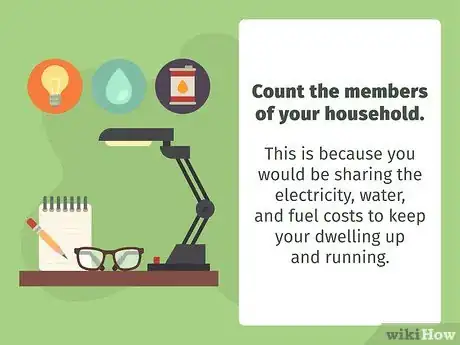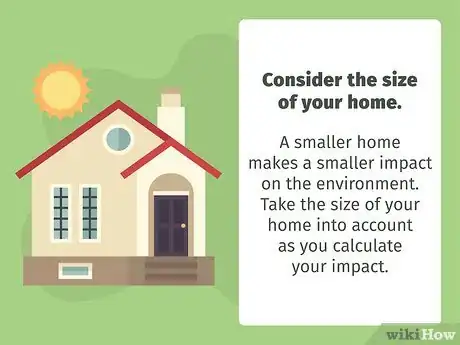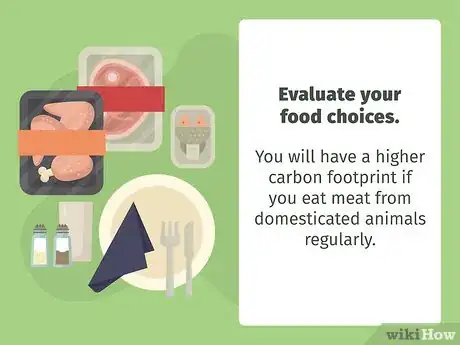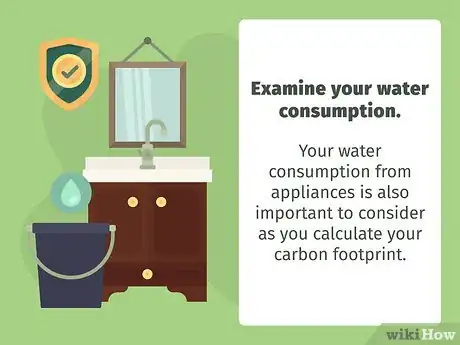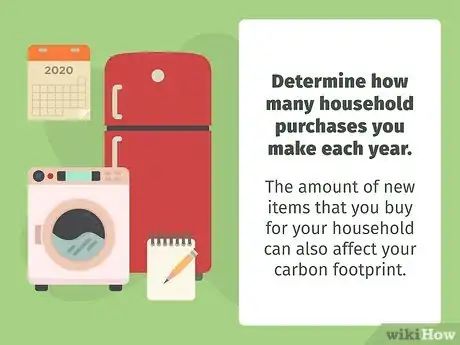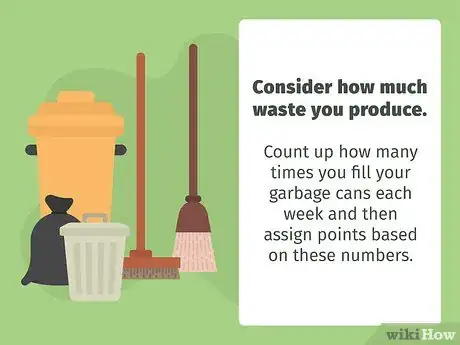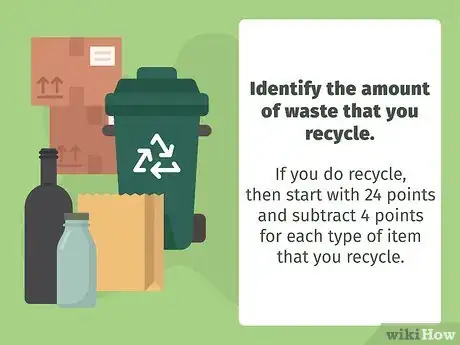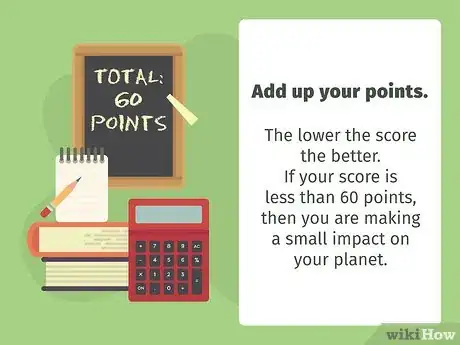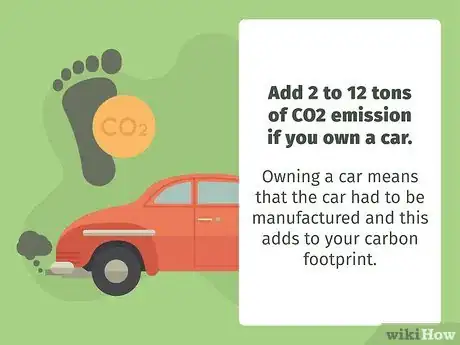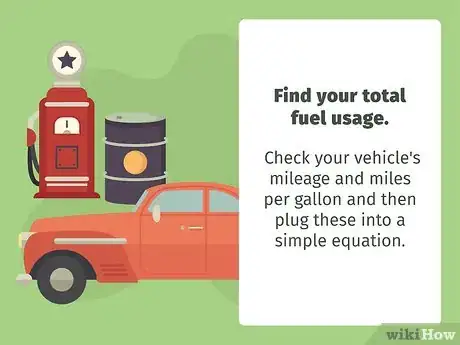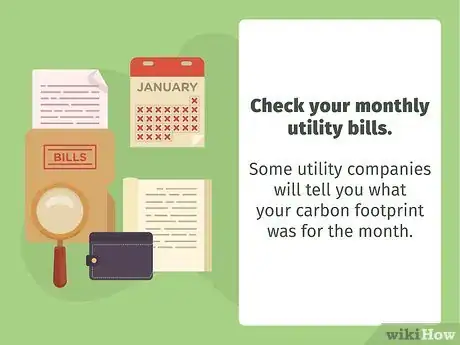This article was co-authored by Carbonfund.org. Carbonfund.org is a Carbon Offset and Environmental Education Organization based in New York. Carbonfund.org is leading the fight against climate change, making it easy and affordable for any individual, business, or organization to reduce and offset their climate impact and hasten the transition to a clean energy future. Carbonfund.org achieves its goals through climate change education, carbon offsets and reductions, and public outreach.
wikiHow marks an article as reader-approved once it receives enough positive feedback. In this case, several readers have written to tell us that this article was helpful to them, earning it our reader-approved status.
This article has been viewed 95,141 times.
Calculating your carbon footprint can help you to identify ways that you can lessen your impact on the environment. Calculating your carbon footprint requires taking lots of different factors into account. You may not be able to get an exact figure to represent your carbon footprint, but you can get a close estimate. You can calculate some things, like your water usage and waste, using points, while others, like the impact of your car and utilities, can be calculated in tons of CO2 emissions.
Steps
Calculating Your Carbon Footprint Points
-
1Count the members of your household. If you live alone, then your carbon footprint will likely be higher than someone who lives in a house or apartment with other people. This is because you would be sharing the electricity, water, and fuel costs to keep your dwelling up and running.[1]
- If you live alone, then add 14 points to your carbon footprint.
- If you share a house or apartment with 1 other person, then add 12 points.
- If you share a house or apartment with 2 other people, then add 10 points.
- If you share a house or apartment with 3 other people, then add 8 points.
- If you share a house or apartment with 4 other people, then add 6 points.
- If you share a house or apartment with 5 other people, then add 4 points.
- If you share a house or apartment with more than 5 other people, then add 2 points.
-
2Consider the size of your home. A smaller home makes a smaller impact on the environment. Take the size of your home into account as you calculate your impact.[2]
- If you have a large house, then add 10 points to your score.
- If you have a medium-sized house, then add 7 points.
- If you have a small house, then add 4 points.
- If you live in an apartment, then add 2 points.
Advertisement -
3Evaluate your food choices. The types of food that you eat can also have an effect on your carbon footprint. You will have a higher carbon footprint if you eat meat from domesticated animals regularly, and you will have a lower carbon footprint if you eat no meat or animal products at all.[3]
- If you eat domestic meat on a daily basis, then add 10 points.
- If you eat domestic meat a few times per week, then add 8 points.
- If you are a vegetarian, then add 4 points.
- If you are a vegan or only eat wild meat, then add 2 points.
- You would also add 12 points if most of the food you eat is prepackaged convenience food, such as frozen pizza, cereal, and potato chips. If you have a good balance of fresh and convenience food, then just add 6 points. If you only eat fresh, locally grown, or hunted food, then add 2 points.
-
4Examine your water consumption. Your water consumption from appliances is also important to consider as you calculate your carbon footprint. Consider how many times per week you run your dishwasher and/or washing machine.
- If you run your dishwasher or washing machine more than 9 times per week, then add 3 points. If you run it 4 to 9 times, then add 2 points. If you run it 1 to 3 times, then add 1 point. If you don't have a dishwasher, then add nothing.
- If you have a dishwasher and a washing machine, then perform the calculation twice.
-
5Determine how many household purchases you make each year. The number of new items that you buy for your household can also affect your carbon footprint. If you buy lots of new things, then your score will be higher than someone who does not buy anything or who only buys secondhand items.
- If you buy more than 7 new pieces of furniture, electronics, or other household gadgets per year, then add 10 points.
- If you purchase between 5 and 7 items, then give yourself 8 points.
- If you purchase between 3 and 5 items, then give yourself 6 points.
- If you purchase less than 3 items, then give yourself 4 points.
- If you purchase almost nothing or only secondhand items, then give yourself 2 points.
-
6Consider how much waste you produce. The more trash cans you fill each week, the larger your carbon footprint will be. Count up how many times you fill your garbage cans each week and then assign points based on these numbers.[4]
- If you fill 4 garbage cans each week, then add 50 points.
- If you fill 3 garbage cans each week, then add 40 points.
- If you fill 2 garbage cans per week, then add 30 points.
- If you fill 1 garbage can per week, then add 20 points.
- If you fill half of a garbage can or less per week, then add 5 points.
-
7Identify the amount of waste that you recycle. If you do not recycle, then add 24 points to your score. However, if you do recycle, then start with 24 points and subtract 4 points for each type of item that you recycle. You can subtract four points for each of the following recycling categories:[5]
- Glass
- Plastic
- Paper
- Aluminum
- Steel
- Food waste (composting)
-
8Tally up your annual transportation scores. You will also need to consider your travel, including how far you travel in a personal vehicle, how far you travel with public transportation, and how far you travel by plane for vacations.
- For your personal vehicle usage, add 12 points if you travel more than 15,000 miles per year. Add 10 points if you travel 10,000 to 15,000 miles per year. Add 6 points if you travel 1,000 to 10,000 miles per year. Add 4 points if you travel less than 1,000 miles per year. Add nothing if you don't have a car.
- For public transportation, add 12 points if you travel more than 20,000 miles per year. Add 10 points if you travel 15,000 to 20,000 miles per year. Add 6 points if you travel 10,000 to 15,000 miles per year. Add 4 points if you travel 1,000 to 10,000 miles per year. Add 2 points for less than 1,000 miles per year. Add nothing if you do not use public transportation.
- For flights, add 2 points if you only travel short distances in 1 year, such as within your state. Add 6 points if you travel further distances, such as to a nearby state or country. Add 20 points if you travel far, such as to another continent.
-
9Add up your points. After you have calculated your points for each category, add them up to get your carbon footprint score. The lower the score the better. If your score is less than 60 points, then you are making a small impact on your planet. If it is higher than 60, then you might want to look for some ways that you can reduce your impact.
- For instance, you can replace old appliances with energy-efficient ones, purchase items with less packaging, use public transportation or carpool, compost, and recycle.
Calculating the Impact of Your Car and Utilities
-
1Add 2 to 12 tons of CO2 emission if you own a car. Owning a car means that the car had to be manufactured and this adds to your carbon footprint. However, keep in mind that the total production footprint of your car is for the lifetime of your car. Therefore, the longer you drive it, the lower the impact will be over time. Start by adding between 5 and 12 tons of CO2 emissions depending on the size of your car.[6]
- If you have a hybrid or electric vehicle, add 2 tons of CO2 emissions.
- If you have a compact or economy-sized car, then add 5 tons of CO2 emissions.
- If you have a medium-sized car, such as a sedan, then add 9 tons of CO2 emissions.
- If you have a large vehicle, such as an SUV or truck, then add 12 tons of CO2 emissions.
-
2Find your total fuel usage. The amount that you drive your car each year can also have an effect on your carbon footprint. You will have a larger carbon footprint if you drive your car frequently. Check your vehicle's mileage and miles per gallon and then plug these into a simple equation.
- Use the equation: total miles driven / miles per gallon = total fuel usage.
- For example, 8,000 / 40 mpg = 200 gallons of fuel used
-
3Multiply your fuel gallons by a conversion factor. To convert the total gallons of fuel you have used driving your car into CO2 emission, you will need to multiply the total by a conversion factor of 19.6.[7]
- Use the equation total fuel used X 19.6 = CO2 emission.
- For example, 200 gallons X 19.6 = 3920 pounds of CO2
- You could also use the EPA's calculator.
-
4Check your monthly utility bills. Some utility companies will tell you what your carbon footprint was for the month. Check your utility bill to see if you can find this information. If not, then check your utility bills to find out what your usage was and plug the numbers into some simple equations to find out what your impact was.
- Multiply your kilowatt hours by 0.994. For example, 67 hrs X 0.994 = 66.60 lbs of CO2.[8]
- Multiply your natural gas usage (therms) by 11.7. For example, 19 therms X 11.7 = 222.3 lbs of CO2.
- Multiply gallons of propane used by 13. For example, 3 gallons of propane X 13 = 39 lbs of CO2.
- Multiply gallons of fuel used by 19.6. For example 15 gallons of fuel X 19.6 = 294 lbs of fuel.
-
5Consider any offsets you have made. If you purchased any carbon offsets from a nonprofit like Carbonfund.org Foundation or did something to offset some of your carbon usage, then you can subtract the amount of carbon that you offset from your totals. For example, 1 tree can absorb a ton of carbon over its lifetime, so if you have a mid-sized sedan, then planting 9 trees could offset the production footprint of your car.[9]
- Check out non-profit groups, such as Carbonfund.org Foundation, that plant trees to help offset emissions. You can donate to have a tree planted and offset some of your emissions.
Community Q&A
-
QuestionWhat trees are best for carbon reduction?
 TheArtOfSarcasmCommunity AnswerAs a genus, oak has been found to be one of the best for carbon reduction. However, the answer to this question is not so straightforward, as there are many other types that can be good at carbon reduction as well like horse-chestnut and trees that are native to an area are often the best at doing the job needed.
TheArtOfSarcasmCommunity AnswerAs a genus, oak has been found to be one of the best for carbon reduction. However, the answer to this question is not so straightforward, as there are many other types that can be good at carbon reduction as well like horse-chestnut and trees that are native to an area are often the best at doing the job needed. -
QuestionWhat is carbon footprint and what are its uses?
 TheArtOfSarcasmCommunity AnswerA carbon footprint is the amount of carbon dioxide that a person emits due to fossil fuel consumption throughout their life. It can be used to calculate an average among people for how much carbon is produced by an average person. This average can also be tracked over time to see if people are at that time using more or less carbon dioxide.
TheArtOfSarcasmCommunity AnswerA carbon footprint is the amount of carbon dioxide that a person emits due to fossil fuel consumption throughout their life. It can be used to calculate an average among people for how much carbon is produced by an average person. This average can also be tracked over time to see if people are at that time using more or less carbon dioxide. -
QuestionWhat does "Consider any offsets you have made" mean?
 Athena21Community AnswerThis means to consider things that you may have done that are positive rather than negative for your carbon footprint. You can then subtract this from your score, because you did something good.
Athena21Community AnswerThis means to consider things that you may have done that are positive rather than negative for your carbon footprint. You can then subtract this from your score, because you did something good.
References
- ↑ https://www3.epa.gov/carbon-footprint-calculator/
- ↑ https://www.epa.gov/ghgemissions/household-carbon-footprint-calculator
- ↑ https://www.nature.org/en-us/get-involved/how-to-help/carbon-footprint-calculator/
- ↑ https://www3.epa.gov/carbon-footprint-calculator/
- ↑ https://www.epa.gov/ghgemissions/household-carbon-footprint-calculator
- ↑ https://www.nature.org/en-us/get-involved/how-to-help/carbon-footprint-calculator/
- ↑ https://www.epa.gov/energy/greenhouse-gas-equivalencies-calculator
- ↑ https://www.epa.gov/energy/greenhouse-gases-equivalencies-calculator-calculations-and-references
- ↑ http://onetreeplanted.org/pages/faq
About This Article
Calculating your carbon footprint involves adding and subtracting points depending on your lifestyle. If you have a medium-size house, you'd add 7 points to your score, whereas if you live in an apartment, you'd only add 2 points. Meat eaters would add 10 points to their score, while vegans would only add 2 points. You would also add or subtract points depending on your water consumption, household purchases, total waste per week, amount of waste recycled, and transportation. If your score is less than 60 points, your carbon footprint is minimal. If it's over 60 points, consider making changes to your lifestyle to reduce your impact. To learn how to tally up your score, keep reading!
